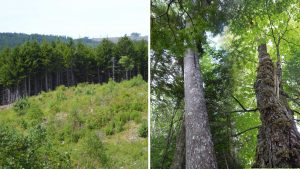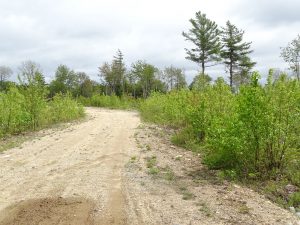CBC Halifax Information Morning has carried several lengthy interviews recently to do with the state of forestry in Nova Scotia, and in particular controversies surrounding cutting on the Western Crown lands by the WestFor consortium.
On June 27, Colin Hughes, owner of G&C Hughes Enterprises Ltd. and Colin Hughes Forestry, was interviewed. Hughes contended that cutting on Western Crown lands by the WestFor consortium is creating a fibre glut which is severely impacting smaller private owners and operators.
On June 28, the WestFor General manager was asked to respond. He defended WestFor’s forestry practices,
On June 29, Nova Scotia Natural Resources Deputy Minister Julie Towers was asked about the NS government’s stand on these issues. She said that Nova Scotia was harvesting only half of the trees that could be sustainably cut.
Today (July 11) forest ecologist Donna Crossland was asked to comment. For the record, an “abbreviated transcript” of the interview (posted online) is given below. I have appended some comments at the end.
Forest ecologist says clearcutting needs to stop
Information Morning – NS July 11, 2017 Season 2017, Episode 300297449
In the intro, Pauline Dakin summarized the previous interviews (cited above), cited the request by Annapolis Co. to be excluded from the WestFor agreement for one year and then quoted at length from a letter they received from Peter Ritchie in Antigonish Co. after the interview with Natural Resources Deputy Minister Julie Towers.
CBC: Writes Ritchie in part:
Deputy minister Julie Towers is either ignorant of the science, misrepresenting the facts, or both.
Thank you for attempting to challenge Ms. Towers on the assertion that Nova Scotia forests have been over-harvested for centuries. Her answer was pathetically inadequate, simply stating that current harvesting is about half that of an arbitrary limit set by her department. I say arbitrary because, without citing the science behind this number, it truly is meaningless. Why didn’t you ask her to support her claim with some actual data?
Your guests from both industry and government have made it clear that they see forestry as a purely economic issue, which is offensive. How about talking to someone who has the chops to address the science?
Donna Crossland is with the Healthy Forest Coalition. We reached her at Tupperville in Annapolis Co.
Pauline Dakin: What do you see when you are out in the woods in western Nova Scotia these days?
Donna Crossland: I see these forests are nearly gone, there has been an overabundance of clearcutting/even-aged management, & whole tree harvesting; it’s got to stop. Nova Scotia is being stripped of her last forest resources by forest industry players who are only interested in their business bottom line and they are backed by DNR…Many of those inside DNR who are making the decisions came from industry and that’s all they know…they are clearly not making management decisions about our forests in our best interest. It is time to clean house and start over with a government department who manages the lands for our well-being, and ecosystems services and wildkife instead of catering to the interest of a bunch of mill-owners.
[But] you won’t catch me pointing my finger at WestFor, they are merely carrying out what DNR has instructed them to do. They are authorized to do the clearcutting on our Crown land forest.
PD: DNR’s Deputy Minister Julie Towers told us we are harvesting only 50% of what we could be cutting, what do you say to that?
DC: Look around us. Our forests are gone. The only way a figure of 7 million cubic meters could be cut annually is on the premise of a 40- or 50-year rotation. This is not Acadian forest management, this is boreal forest management, these short harvest rotations. Forty- or fifty-year rotations will not produce the higher quality temperate species that should be featured in our Acadian forest; that won’t provide us with ecosystems services and wildlife habitat that we require in this forest region.PD: Can you talk about what the plan should be for different kinds of forest?
DC: For starters, the Acadian forest is an extremely complex, multi-aged forest ecosystem that should be featuring trees dominated by red spruce, yellow birch, white pine, eastern hemlock, these are temperate species capable of growing for 100s of years… and most of it should be 100 years or older. That’s what it was prior to European colonization, that’s what the Acadian forest of NS would produce if we stopped meddling in it with such a heavy hand. Appropriate harvesting must involve partial harvesting systems, but we are currently doing 90% by clearcutting which is entirely inappropriate.PD: What response do you get from DNR when you raise these concerns with them?
DC: They don’t address some of the very fundamental issues, the science that they are conveniently overlooking, for instance the soil science… In SW Nova Scotia, soils.. are very deficient in calcium and nitrogen, if you clearcut them when already there are low levels of nutrients, the rest is leached out in rain and you don’t recover them for a long time.Also the carbon: up to 60% of carbon is stored in the soil, but when soil is exposed in a harsh dry, clearcut environment, it is mobilized and released as atmospheric carbon dioxide, a greenhouse gas… so it is laughable when the government and DNR speak of green biomass energy when they are producing woodchips from clearcuts and producing far more greenhouse gasses than if they left the forest standing.
PD: The province is going to have an independent person do another forestry review, what are your hopes about that?
DC: Once burnt twice shy. As you are probably aware, I worked alongside Bob Bancroft in 2009/10 during our Natural Resources Strategy and we produced some very strong recommendations that were based on what Nova Scotians clearly voiced; they were also based on science and all of that was ignored.Industry did a lot of fear-mongering and so none of that was implemented… the one small thing that perhaps we gained: clearcutting was supposed to be reduced by 50%; the Liberals have now walked away from that commitment. Now we’re hearing we are going to have another independent review. I’m sorry but the science hasn’t changed. It’s still the Acadian forest, it’s still doing just as much damage to soil nutrients and carbon and wildlife habitat… we far worse off than in 2009/10, we’re even more depleted and impoverished.
So this independent review, I say Hurry Up and make a decision that is better for Nova Scotians, better for the forest industry in general, better for private woodlot owners. But I’m not optimistic, so far all we hear are industrial interests dominating the discussion and sociological, ecological and economic benefits are being ignored… it’s broken.
PD: We heard from a private woodlot owner last month who was saying WestFor is glutting the market and pushing him out of the business… when you have so many competing interests, how do you protect peoples livelihoods and the health of the forest?
DC: We obviously need a more balanced approach; there are enormous piles of wood on Crown land that didn’t make it to the mills before they shut down this spring that are now just rotting, yet we are still clearcutting into oblivion.So, yes, private woodlot owners can’t thrive when this Crown land wood is being liquidated at such a pace… Other entities such as Woodscamp cant make a go of it here under the current economic climate, the Community Forest is struggling. We need change. The ecological issues are being ignored; we all lose including the trout and salmon in the streams, nesting songbirds, slowly starving displaced wildlife are becoming refugees on these barren landscapes. We need to be focussing on the answers.
This independent review I hope will look at some of the obvious solutions. Tourism for example produces 15X more revenues than our three primary Nova Scotia industries combined. In 2013 according to the Corporate Research Associates, forestry produced 55 million dollars in revenue, whereas tourism produced 823 million in revenue. So why not concentrate on Nova Scotia’s natural beauty and her natural resources and forests… the Wentworth Valley doesn’t need to be clearcut when it can make up to 15 X more profit from tourism than forestry. Tourism is an enabler.
PD: You say that animals are starving. Can that be clearly linked to clearcuts?
DC: Absoutely. Partial cutting.. is a smokescreen. We should be doing partial cuts in our Acadian forests, but most end up being uniform shelterwoods which is a fancy term for 2-stage clearcuts; they harvest part of the wood, and 5-6 maybe up 10 years later they harvest the rest. So if you are a flying squirrel you.. have lost your habitat and your food source; wildlife are displaced, they become refugees.[As it was approaching the time for the 8 a.m. news, the interview had to be curtailed; PD thanked Donna Crossland for the interview]
PD: DC is with the Healthy Forest Coalition. She also an employee with Parks Canada but she is not speaking on behalf of PC today.
——-
Ms Crossland said that tourism brings in 15X the revenue of forestry which I wondered about. It’s hard to find straight-forward stats in the public domain that compare the two sectors but it is clear from some figures that I could find that tourism generates several fold more tax revenue and employment than forestry:
In 2016, tourism was valued at $2.6 billion (1.5 from out of province), directly and indirectly. 1
In 2015, Forestry was valued at $2.1 billion, directly and indirectly. 2In 2010 (when it was valued at 2.02 billion) tourism generated $261 million dollars in federal and provincial taxes; and created 34,400 jobs directly and indirectly. 3
In 2015, the Nova Scotia forest products industry generated a total of: $49 million in taxes on goods and services purchased, $30 million in provincial and federal income taxes and created 11,500 jobs directly and indirectly. 11. Tourism NS, Record-setting Tourism Numbers for Nova Scotia in 2016
2. Forest Nova Scotia Economic Impact Report – Gardner Pinfold (Jan 2017)
3. Tourism NS: Nova Scotia’s Visitor Economy – 2010

Two approaches to forestry in Nova Scotia. One produces high value wood as well as sequestering carbon, providing habitat for wildlife and peace of mind to visitors.
There may be other economic tradeoffs with clearcut/even-aged management forestry, e.g. according to the Forest Nova Scotia Economic Impact Report, Fishing, Hunting and Trapping generate approx. $530 million in GDP, compared to approx. $425 million in forest products.
If we reduced clearcutting substantially we could lose some revenue over the short term. However, it’s predictable as well, that if we don’t reduce clearcutting, we will lose revenue in other sectors over the longer term, in addition to many other benefits afforded by a healthy Acadian forest.


